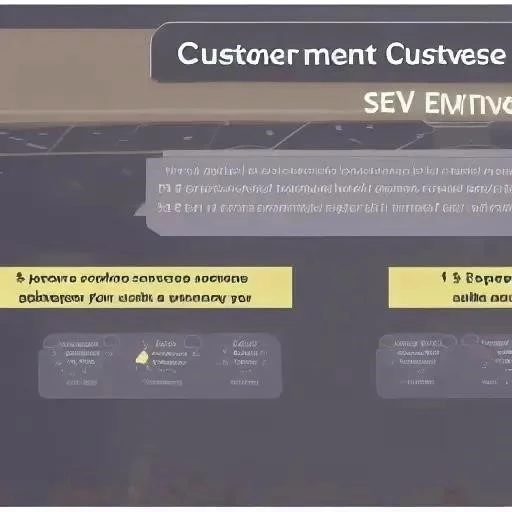Optimizing Customer Service Levels: A Comprehensive Guide
Stop boring customer service! Define SMART goals, boost satisfaction, and watch your business thrive. Learn how to level up your customer service game today!

In today’s competitive marketplace, understanding and optimizing customer service levels is paramount for business success. It goes beyond simply answering phones; it encompasses every interaction a customer has with your brand, from initial inquiry to post-purchase support. Defining your desired customer service levels involves setting specific, measurable, achievable, relevant, and time-bound (SMART) goals. These goals should align with your overall business objectives and reflect the needs and expectations of your target audience. Failing to prioritize this aspect can lead to customer dissatisfaction, negative reviews, and ultimately, a loss of revenue.
Understanding Different Levels of Customer Service
Customer service isn’t a one-size-fits-all concept. Different companies, and even different customer segments within the same company, may require varying levels of service. Let’s explore some common approaches:
- Basic Customer Service: Focuses on efficiently resolving customer issues and answering basic inquiries. Think of call centers that provide standard responses to common questions.
- Enhanced Customer Service: Goes beyond basic support to proactively anticipate customer needs and offer personalized solutions. This might involve offering tailored recommendations or providing dedicated account managers.
- World-Class Customer Service: Aims to exceed customer expectations at every touchpoint, creating memorable and delightful experiences. This often involves empowering employees to go the extra mile and fostering a customer-centric culture throughout the organization.
Factors Influencing Customer Service Level Decisions
Several factors should be considered when determining the appropriate level of customer service for your business:
- Industry: Some industries, like luxury goods or high-tech services, demand a higher level of customer service than others.
- Target Audience: Understanding your customer demographics, preferences, and expectations is crucial.
- Product/Service Complexity: More complex products or services often require more comprehensive customer support.
- Budget: Implementing higher levels of customer service can be expensive, so it’s important to consider your budget constraints.
- Competitive Landscape: Analyze what your competitors are offering in terms of customer service and strive to differentiate yourself.
The Importance of Measurement and Monitoring
Once you’ve defined your desired customer service levels, it’s essential to track and measure your performance against those goals. Key metrics to monitor include:
- Customer Satisfaction (CSAT) Scores: Measure customer satisfaction using surveys or feedback forms.
- Net Promoter Score (NPS): Gauge customer loyalty and willingness to recommend your brand.
- Resolution Time: Track the average time it takes to resolve customer issues.
- First Contact Resolution (FCR): Measure the percentage of issues resolved on the first interaction.
- Customer Retention Rate: Monitor the percentage of customers who continue to do business with you over time.
Regularly reviewing these metrics will help you identify areas for improvement and ensure that you’re consistently meeting your customer service goals. This data-driven approach will allow you to refine your strategies and deliver exceptional service.
Striking the Right Balance
Finding the optimal customer service levels is a balancing act. You need to provide adequate support to meet customer needs without overspending or sacrificing profitability. Consider implementing tiered service levels to cater to different customer segments or product tiers. For example, offering premium support to high-value customers while providing basic support to others. The key is to continuously analyze your data, gather customer feedback, and adapt your approach as needed.
Ultimately, effective customer service levels are not static; they evolve with your business and the changing needs of your customers. It requires ongoing attention, investment, and a commitment to providing exceptional experiences at every stage of the customer journey.
The Role of Technology in Optimizing Customer Service Levels
Technology plays a crucial role in achieving and maintaining desired customer service levels. From CRM systems to AI-powered chatbots, various tools can streamline processes, enhance efficiency, and improve the overall customer experience. Implementing a robust CRM system, for instance, allows you to centralize customer data, track interactions, and personalize communication. This enables your team to provide more informed and targeted support. Chatbots can handle basic inquiries, freeing up human agents to focus on more complex issues. Furthermore, data analytics platforms can provide valuable insights into customer behavior and preferences, allowing you to proactively address potential problems and personalize service offerings.
Integrating Technology Strategically
However, it’s important to remember that technology is merely a tool. Its effectiveness depends on how strategically it’s integrated into your overall customer service strategy. Avoid simply implementing technology for the sake of it. Instead, carefully assess your needs, identify areas where technology can make a significant impact, and choose solutions that align with your business goals. Consider the following:
- Scalability: Choose technologies that can scale as your business grows.
- Integration: Ensure that your chosen technologies integrate seamlessly with your existing systems.
- User-Friendliness: Select tools that are easy for your team to use and understand.
- Security: Prioritize data security and privacy when selecting technology solutions.
Moreover, don’t neglect the human element. Technology should augment, not replace, human interaction. Train your employees to effectively use these tools and empower them to provide personalized service that goes beyond what technology can offer.
Building a Customer-Centric Culture
While technology and well-defined processes are important, the foundation of exceptional customer service lies in a customer-centric culture. This means embedding a customer-first mindset into every aspect of your organization, from leadership to frontline employees. It involves empowering employees to make decisions that benefit customers, actively soliciting customer feedback, and continuously striving to improve the customer experience. To foster this culture:
- Empower your employees: Give them the autonomy to resolve customer issues without unnecessary bureaucracy.
- Listen to your customers: Actively solicit feedback through surveys, social media, and other channels.
- Recognize and reward excellent service: Celebrate employees who go above and beyond to provide exceptional customer experiences.
- Provide ongoing training: Equip your employees with the skills and knowledge they need to excel in customer service.
By cultivating a customer-centric culture, you can create a positive and memorable experience for every customer, fostering loyalty and advocacy.
‘
The Future of Customer Service Levels
Looking ahead, customer service levels are poised for continued evolution, driven by advancements in technology and shifting customer expectations. We can anticipate a greater emphasis on personalization, proactive service, and seamless omnichannel experiences. Artificial intelligence (AI) will likely play an even more prominent role, powering more sophisticated chatbots, predictive analytics, and personalized recommendations. Customers will expect businesses to anticipate their needs and provide tailored solutions before they even ask. This necessitates a shift from reactive to proactive service, where businesses actively monitor customer behavior and identify potential issues before they escalate. Furthermore, the lines between different communication channels will continue to blur, with customers expecting a seamless and consistent experience regardless of how they interact with a business. The ability to transition seamlessly between phone, email, chat, and social media will become increasingly important.
Preparing for the Future
To prepare for this evolving landscape, businesses must invest in the right technologies, cultivate a customer-centric culture, and continuously adapt their strategies. This requires a willingness to embrace innovation, experiment with new approaches, and prioritize the customer experience above all else. Consider these key steps:
- Embrace AI and automation: Explore how AI-powered tools can enhance your customer service capabilities.
- Invest in omnichannel solutions: Ensure a seamless and consistent experience across all communication channels.
- Prioritize personalization: Tailor your service offerings to meet the unique needs of each customer;
- Foster a culture of continuous improvement: Regularly analyze your performance and identify areas for optimization;
- Stay informed: Keep abreast of the latest trends and technologies in the customer service landscape.
By proactively addressing these challenges and opportunities, businesses can position themselves for success in the future of customer service.
Defining and maintaining appropriate customer service levels is essential for business success in today’s competitive environment. It’s a complex undertaking that requires a deep understanding of customer needs, a commitment to continuous improvement, and a willingness to embrace innovation. Effective customer service levels are not just about resolving issues; they are about building relationships, fostering loyalty, and creating memorable experiences that differentiate your brand. By carefully considering the factors influencing customer service level decisions, measuring your performance, and adapting your approach as needed, you can create a customer-centric culture that drives long-term success; Ultimately, superior customer service levels become a competitive advantage. By focusing on providing exceptional experiences and consistently exceeding expectations, you can build a loyal customer base, increase brand advocacy, and drive sustainable growth. Remember that the quality of customer service levels you provide directly impacts your bottom line.
‘
The Importance of Employee Empowerment and Training
The effectiveness of any customer service strategy hinges on the capabilities and motivation of your employees. Empowered and well-trained employees are better equipped to handle complex customer issues, make informed decisions, and provide personalized service. Employee empowerment involves granting employees the authority to resolve customer problems without requiring constant approval from supervisors. This not only speeds up resolution times but also fosters a sense of ownership and accountability among employees. When employees feel trusted and valued, they are more likely to go the extra mile to satisfy customers.
Training plays a vital role in equipping employees with the skills and knowledge they need to excel in customer service. Effective training programs should cover a range of topics, including product knowledge, communication skills, conflict resolution, and problem-solving techniques. Furthermore, training should be ongoing, not a one-time event. Regular refresher courses and updates on new products, services, and technologies are essential to ensure that employees remain competent and confident. Consider implementing the following training strategies:
- Role-playing exercises: Simulate real-life customer interactions to help employees practice their skills.
- Mentorship programs: Pair experienced employees with new hires to provide guidance and support.
- Online learning modules: Offer flexible and accessible training options that employees can complete at their own pace.
- Customer feedback analysis: Use customer feedback to identify areas where employees need additional training.
By investing in employee empowerment and training, you can create a workforce that is capable of delivering exceptional customer service consistently.
Measuring and Analyzing Customer Service Performance
Measuring and analyzing customer service performance is crucial for identifying areas of strength and weakness and for tracking progress over time. Without accurate data, it’s impossible to know whether your efforts are paying off or whether you need to make adjustments to your strategy. There are a variety of metrics that can be used to measure customer service performance, including:
| Metric | Description | Importance |
|---|---|---|
| Customer Satisfaction (CSAT) | Measures overall customer satisfaction with a specific interaction or experience. | Provides a direct measure of customer happiness and loyalty. |
| Net Promoter Score (NPS) | Measures the likelihood of customers recommending your business to others. | Indicates customer advocacy and potential for word-of-mouth marketing. |
| Customer Effort Score (CES) | Measures the effort required by customers to resolve an issue or complete a task. | Identifies areas where the customer experience can be simplified and streamlined. |
| Average Resolution Time | Measures the average time it takes to resolve a customer issue. | Indicates the efficiency of your customer service processes. |
| First Contact Resolution (FCR) | Measures the percentage of customer issues that are resolved on the first contact. | Reflects the effectiveness of your support team and knowledge base. |
In addition to tracking these metrics, it’s important to analyze the data to identify trends and patterns. This can help you understand the root causes of customer issues, identify areas for improvement, and make data-driven decisions. Consider using data visualization tools to present your findings in a clear and concise manner. Regularly review your customer service performance data and use it to inform your strategic planning. By continuously measuring and analyzing your performance, you can ensure that your customer service strategy remains effective and aligned with your business goals.




